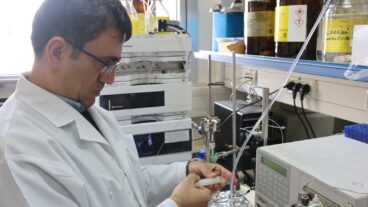A substance that destroys cells infected with deadly HIV and could prevent AIDS, has been developed in Israel after a decade of cooperation between chemists and biologists.

A substance that destroys cells infected with the deadly human immunodeficiency virus (HIV) has been developed by researchers at the Hebrew University (HU) of Jerusalem.
The breakthrough, reported by ISRAEL21c in September, resulted from years of cooperative lab work between professors Abraham Loyter from HU’s Alexander Silberman Institute of Life Sciences and Assaf Friedler of the university’s Institute of Chemistry, carried out by Dr. Aviad Levin and Dr. Zvi Hayouka.
“We did the chemistry and they did the biology,” Friedler tells ISRAEL21c. “You cannot do such things without interdisciplinary cooperation. We made the compounds and they tested them on HIV-infected cells.”
Preventing, not just managing, AIDS
Loyter explains that the important advance came after a decade of research: “We have worked on understanding different aspects of the HIV infection process from a molecular point of view for the last 10 years,” he says.
The latest of many articles the researchers have published about these studies caused a stir in the scientific community when it came out online on August 19 in the scientific journal AIDS Research and Therapy.
The focus of all the excitement is a unique peptide, a short protein-like substance made by Friedler’s team. When Loyter’s researchers applied it to human cell cultures, the peptide destroyed HIV-infected cells within two weeks but did not harm healthy cells.
The most advanced drugs available today can kill the virus or slow its infection process, but they cannot eradicate already infected cells, in which the dormant virus can undergo a process of activation resulting in AIDS.
HIV, carried by an estimated 33.4 million people worldwide, breaks down the body’s immune system. After enough cells are infected, acquired immunodeficiency syndrome (AIDS) sets in, leaving carriers defenseless against many illnesses. The Israeli discovery holds the promise of preventing AIDS, not merely managing it.
Causing HIV cells to self-distruct
Loyter explains that ordinarily, no more than three copies of the viral DNA become integrated into HIV-infected cells. Though many additional copies are present inside those cells, their integration is blocked by a mechanism caused by an interaction between two proteins. Friedler’s peptide interrupts the protein interaction, freeing up to 15 copies of the viral DNA to become integrated into the host cell. This onslaught triggers the cell to self-destruct.
The researchers have registered a patent on their discovery through Yissum, the Hebrew University’s technology transfer body. However, they caution that it could take years before a commercial treatment based on their science appears on the market.
“We have started the process of protecting the IP [Intellectual Property] of this extremely promising invention and licensing it out,” says Dana Gavish-Fridman, licensing liaison for Yissum. “We will look for an industrial partner who can take the technology to R&D and then clinical trials that will lead to products providing relief to patients. There’s a long way to go, and at the beginning we are always looking for seed funding so we can license it to a good home.”
In the meantime, Loyter says, “We are continuing with our studies at the level of cell cultures. In order to look at its clinical aspects, the next step is animal studies, which involves a lot of money.”
Friedler (39) tells ISRAEL21c that he has always been intrigued by research that borders on both chemistry and biology, noting: “We have a teaching program combining both, of which I was head for five years.” Following post-doctoral studies at Cambridge University, he is perfectly content to confine his interest to the laboratory. “There is nothing like the academic life,” he says.
For his part, Loyter has been at the Hebrew University for his entire professional career, following post-doc work at Cornell University. Now 74, he sees this new breakthrough as one of the more exciting projects he’s worked on. He is also involved in research into the molecular aspects of cell fusion and studies on plant viruses and genetic engineering.













